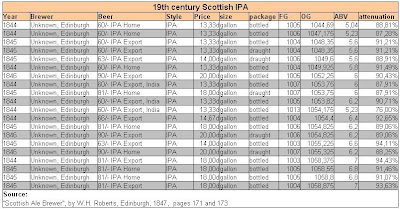IPA
There was probably more diversity amongst IPA's that is generally reckoned today. A look at the IPA's analysed in the 1840's, shows that they had a wide range of gravities, both for the home and export markets. The beers tested were brewed in London, Scotland, Burton and other English towns.



 The weakest had a gravity of just 1045º, not that much different from some modern British IPA's. That's the same strength as a Table Beer of the time. One India export version had a gravity of just 1054º, much lower than you would expect. Just to be very clear about this point: IPA was not strong compared to other Beers and Ales of the period. The strongest one analysed had a gravity of 1070º, lower than the Griffin Brewery X Ale, which was 1073º. Roberts actually stated "As the worts for the production of India beer are of low gravity . . ." (Source: "Scottish Ale Brewer", WH Roberts, Edinburgh, 1847, page 161.)
The weakest had a gravity of just 1045º, not that much different from some modern British IPA's. That's the same strength as a Table Beer of the time. One India export version had a gravity of just 1054º, much lower than you would expect. Just to be very clear about this point: IPA was not strong compared to other Beers and Ales of the period. The strongest one analysed had a gravity of 1070º, lower than the Griffin Brewery X Ale, which was 1073º. Roberts actually stated "As the worts for the production of India beer are of low gravity . . ." (Source: "Scottish Ale Brewer", WH Roberts, Edinburgh, 1847, page 161.)Not all the beer exported to India arrived in a good state. Some was just poured into the harbour on arrival. Roberts remarks of "miserably low" gravities of some of the export IPA's he analysed: "Even keeping beers for home consumption, were they made from such low gravities as some to be found in this table, would certainly not stand over the summer." (Source: "Scottish Ale Brewer", WH Roberts, Edinburgh, 1847, page 157.)
The average gravity of export IPA's from noted breweries Roberts analysed was 1068º, those for home consumption from the same breweries 1062º. There were cheaper, weaker beers from other breweries which averaged just 1055º. Surprisingly, some of these survived not just the trip to India, but back to Britain again and were, at 18 months old, still prefectly sound. (Source: "Scottish Ale Brewer", WH Roberts, Edinburgh, 1847, pages 169-170.)
The demand for this type of beer had increased enormously. Tizard mentioned "the great demand for bitter ale, particularly for the Indian possessions" (Source: "The Theory and Practice of Brewing" by W.L. Tizard, London, 1846, page 104.) The big Burton brewers, Bass and Allsopp, placed advertisements in newspapers boasting of the size of their India trade.
 This is Allsopp's:
This is Allsopp's:From Oct 1, 1842 to Oct 1843
Allsopp____9,499 hogsheads
Bass______4,800 hogsheads
This is Bass's:
From Oct 1843 to Feb 1 1844
Allsopp____6,868 hogsheads
Bass______5,786 hogsheads
Hodgson ___606 hogsheads
(Source: "Scottish Ale Brewer", WH Roberts, Edinburgh, 1847, pages 156-157.)
 To put these figures into perspective, 9,499 hogsheads is 14,248.5 barrels. In 1843, Barclay Perkins brewed 389,835 barrels and Truman 344,342, put another way, around 1,000 barrels a day. The India trade was pretty modest compared to the business to be had in London. Allsopp and Bass's annual sales in India combined were less than a week's production of the 5 largest London Porter breweries. (Source: "The British Brewing Industry, 1830-1980" T. R. Gourvish & R.G. Wilson, pages 610-611.)
To put these figures into perspective, 9,499 hogsheads is 14,248.5 barrels. In 1843, Barclay Perkins brewed 389,835 barrels and Truman 344,342, put another way, around 1,000 barrels a day. The India trade was pretty modest compared to the business to be had in London. Allsopp and Bass's annual sales in India combined were less than a week's production of the 5 largest London Porter breweries. (Source: "The British Brewing Industry, 1830-1980" T. R. Gourvish & R.G. Wilson, pages 610-611.)But IPA wasn't just exported to India. "What is called India beer is now very generally used in Great Britain. (Source: "Scottish Ale Brewer", WH Roberts, Edinburgh, 1847, page 158.) Roberts believed that it was demand from expats returning from India that prompted brewers to make IPA available in Britain. (Source: "Scottish Ale Brewer", WH Roberts, Edinburgh, 1847, page 158.)
IPA was recommended by doctors for its tonic properties: "As a strengthening, exhilirating and wholesome beverage." (Source: "Scottish Ale Brewer", WH Roberts, Edinburgh, 1847, page 158.)










































































No comments:
Post a Comment